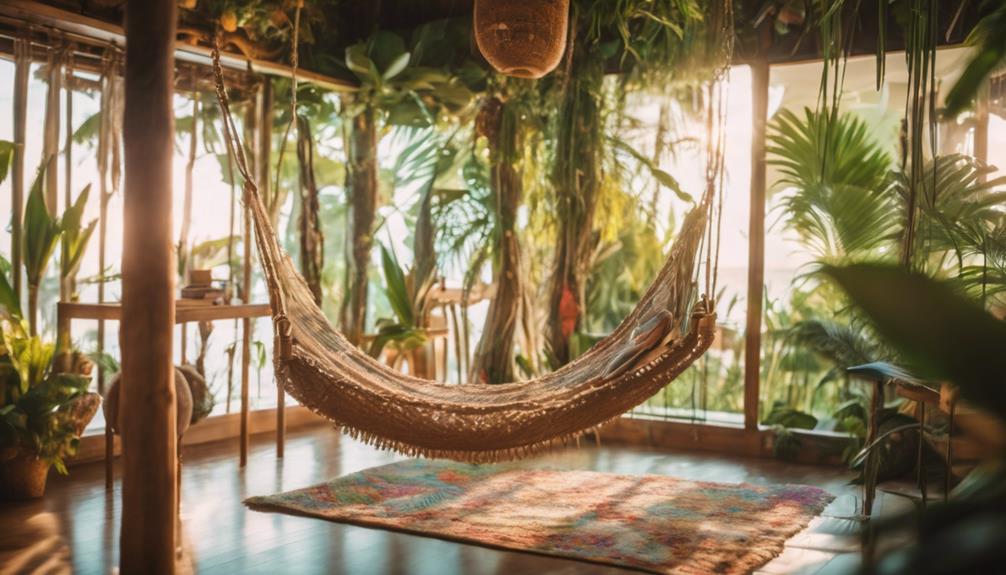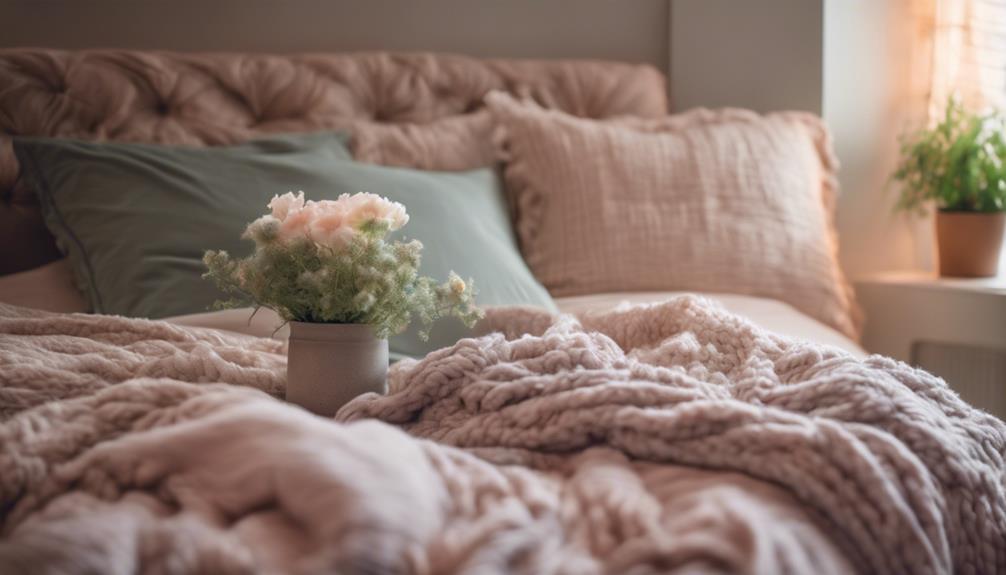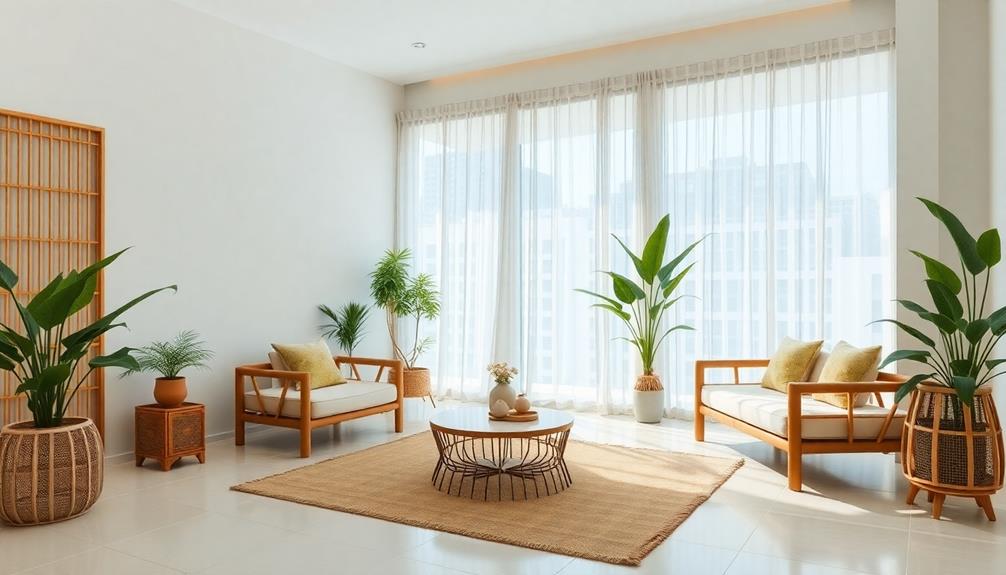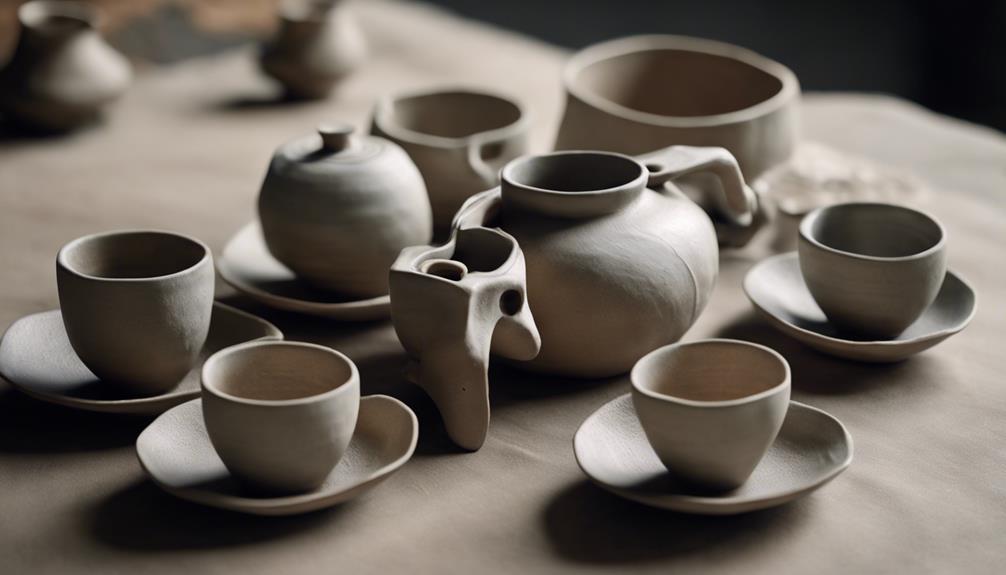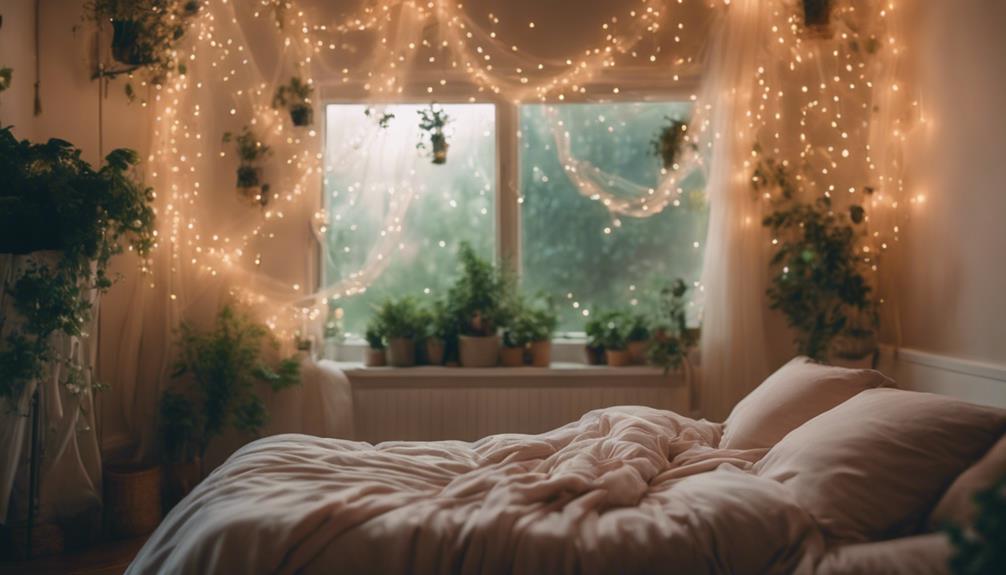Transform your space into a tropical paradise that wows everyone! Start by incorporating bold colors like turquoise, lime green, and sunny yellow to create a vibrant atmosphere. Use natural materials like rattan and bamboo for furniture and fun fixtures like hammock chairs. Don't forget playful decorative elements, like ceramic flamingo figurines and tropical wall art. Lighting plays an essential role, so consider coconut shell pendant lights or whimsical string lights. Finally, choose flooring options like bamboo or cork to enhance the warm, inviting vibe. Keep exploring to uncover more tips and tricks for your perfect tropical oasis!
Key Elements
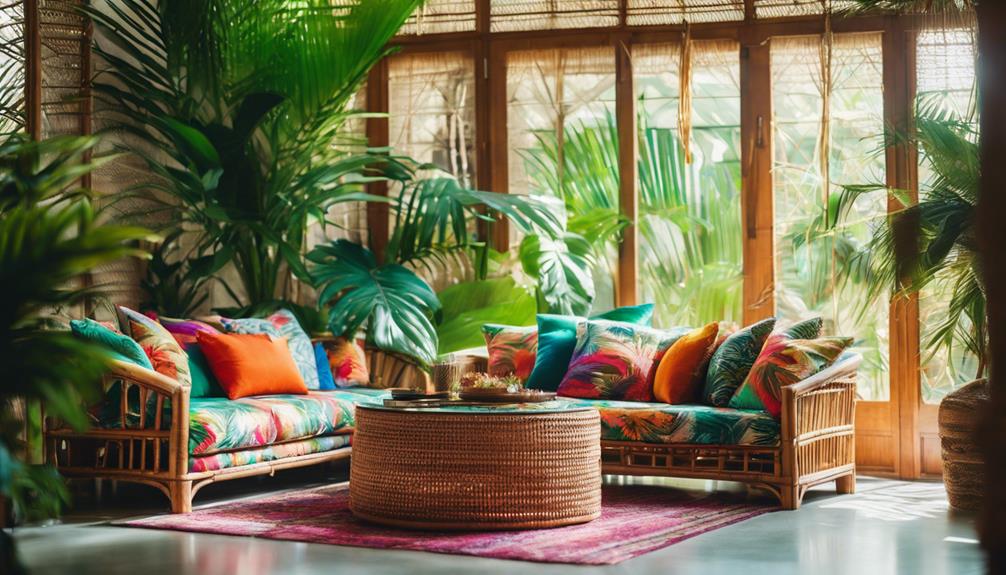
When creating a tropical room, your color scheme plays an essential role in setting the mood.
You'll want to choose vibrant hues that reflect the lush landscapes of the tropics, while also considering the materials and textures that can enhance the overall vibe.
Color Scheme
To create a vibrant tropical room decor, you should incorporate bold colors like greens, turquoises, and zesty citrus hues, which capture the essence of lush landscapes and relaxation.
Your color scheme should include lively shades like lime green, sunny yellow, and coral or peach tones, as these evoke the spirit of a tropical paradise.
Consider painting an accent wall in one of these bright colors to make a statement, while pairing it with tropical-themed accessories like cushions and artwork.
To achieve balance, mix in earthy tones, allowing your vibrant accents to pop without overwhelming the space. Neutrals can also soften any bold colors, ensuring that the room feels inviting.
Don't forget to integrate ocean-inspired blues and sandy beiges into your palette; these hues foster a serene atmosphere reminiscent of beach settings.
Additionally, using tropical motifs in prints, such as palm fronds and exotic flowers, can enhance your decor and maintain a cohesive tropical theme throughout the room.
With the right color scheme, you'll create an inviting oasis that wows everyone who enters your space!
Materials
Natural materials like rattan, bamboo, and wood are essential for creating that cozy, inviting vibe in your tropical room decor. These elements enhance the overall aesthetic, making your space feel like a serene getaway.
Incorporating bright color palettes featuring greens, turquoise, and zesty citrus hues not only evokes the essence of tropical landscapes but also contributes to a relaxed atmosphere.
To further enhance your tropical decoration, consider adding soft natural fibers such as jute rugs and woven seagrass baskets. These materials bring a laid-back vibe and complement the overall design.
Tropical-themed textiles with botanical prints in lightweight fabrics like cotton or silk add breathability and comfort, making your space feel fresh and airy.
Don't forget to integrate unique decorative items made from raw materials like coconut shells or upcycled fabrics. These touches add character and a playful element to your decor, making it truly one-of-a-kind.
Textures
Textures play an essential role in tropical room decor, enhancing the overall aesthetic and creating a welcoming atmosphere that feels both fresh and inviting. To achieve this, incorporate natural textures like rattan, wicker, and bamboo furniture, which promote a light, airy feel in your space.
Adding jute rugs and woven seagrass baskets will bring warmth and coziness, laying the groundwork for that laid-back vibe typical of tropical themes. For your curtains and upholstery, opt for soft natural fibers such as cotton or linen. These materials contribute to a breathable environment, essential for that authentic tropical experience.
Don't shy away from layering textures—vibrant botanical prints in textiles and accessories can effectively enhance visual appeal and depth. Experimenting with raw materials like coconut shells and driftwood not only adds character but also emphasizes your connection to nature, a key element in tropical design.
Essential Fixtures and Furniture
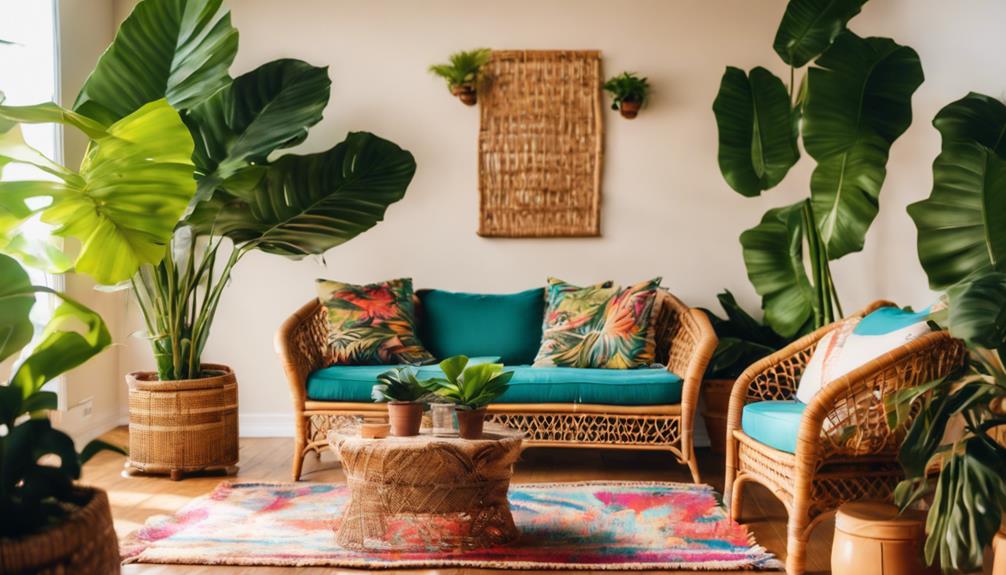
To truly embrace the tropical vibe, you need to choose essential fixtures and furniture that enhance relaxation and style.
A hammock chair offers the perfect spot to unwind, while a tropical-themed ceiling fan keeps the air flowing.
Don't forget to add a hanging macrame plant holder to bring in that lush greenery and complete the look!
Hammock Chair for Relaxation
A hammock chair transforms any space into a serene retreat, inviting you to unwind and embrace relaxation with its gentle swaying motion. This unique and cozy seating option doesn't just look great; it actively promotes relaxation by helping to reduce stress and anxiety levels.
Whether you choose one made of cotton, polyester, or woven fabric, you'll find comfort and durability that perfectly complements your tropical decor theme.
Hammock chairs are versatile fixtures, easily hung from ceilings or sturdy stands, making them suitable for both indoor and outdoor spaces. By incorporating vibrant colors and tropical patterns, you can enhance the overall aesthetic of your room, creating a lively atmosphere reminiscent of paradise.
Imagine curling up with a good book or sipping your morning coffee while gently rocking back and forth—pure bliss!
Incorporating a hammock chair into your room encourages a laid-back lifestyle, making it an ideal focal point for relaxation. So, why not create that cozy nook you've always dreamed of? With a hammock chair, you'll transform your space into a haven of tranquility that you and your guests will love.
Tropical-Themed Ceiling Fan
Enhancing your tropical room decor with a ceiling fan not only boosts airflow but also adds a stylish touch inspired by nature. When choosing a ceiling fan, look for designs featuring palm fronds or bamboo that evoke a tropical vibe. These elements seamlessly integrate into your overall decor and enhance the aesthetic appeal of your space.
Consider fans in vibrant colors like greens, blues, or corals, which complement the bold color palette typical of tropical environments. Natural materials like wood or rattan further align your fan with the rustic, earthy elements found in tropical decor, making it a key decorative element in your room.
Additionally, opt for ceiling fans with integrated lighting options. Warm, inviting light creates a cozy ambiance, perfect for relaxing evenings in your tropical paradise. Beyond aesthetics, energy-efficient ceiling fans help maintain a comfortable temperature while reducing electricity costs, promoting sustainability in your home.
Investing in a tropical-themed ceiling fan not only enhances comfort but also elevates the style of your space, ensuring your tropical room decor truly wows everyone who enters.
Hanging Macrame Plant Holder
Hanging macrame plant holders bring a stylish touch to your tropical decor while maximizing vertical space for your favorite greenery. These fixtures not only save valuable floor space but also create a stunning display for your tropical plants. With intricate knot designs, they add texture and visual interest, enhancing the overall aesthetic of your room.
Made from natural materials like cotton or jute, macrame hangers promote a rustic and eco-friendly vibe, perfect for sustainable decor practices. They're incredibly versatile, accommodating a range of plant sizes from small ferns to larger monstera plants, making them ideal for various spaces and styles.
Incorporating hanging macrame plant holders not only introduces vibrant greenery into your space but also contributes to a lush, tropical environment. By arranging multiple holders at different heights, you create a dynamic visual effect that draws the eye and adds depth to your decor.
These decorative items are perfect for transforming otherwise dull corners into vibrant showcases filled with life. So, hang a few macrame plant holders, and let your tropical paradise flourish!
Lighting Ideas
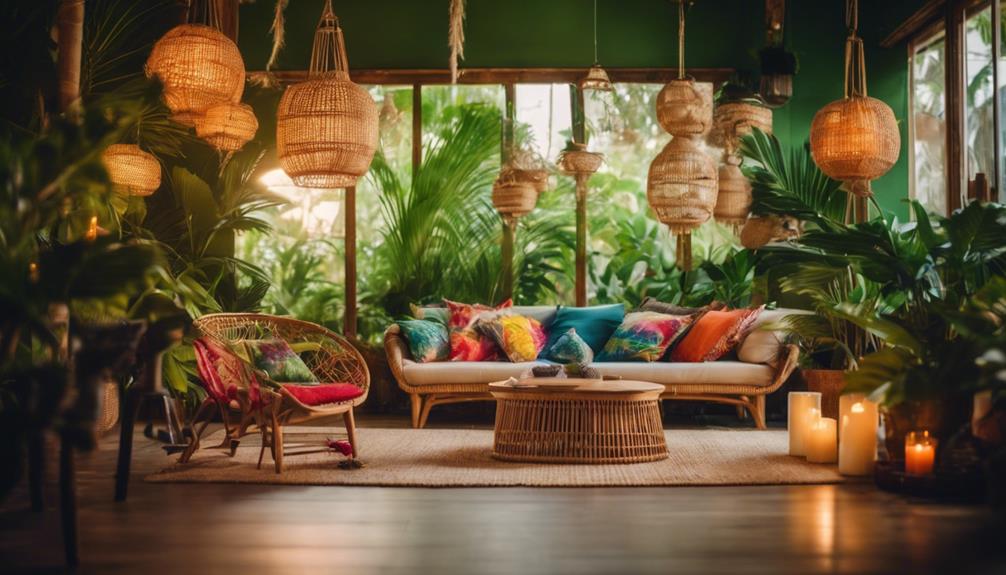
When it comes to lighting your tropical room, think about how pendant lights can add flair and function.
Coconut shell pendant lights and tropical lantern string lights not only brighten the space but also enhance the theme.
Also, consider tropical bamboo floor lamps for a warm, inviting glow that complements your decor.
Tropical Pendant Lights
How can tropical pendant lights transform your space into a vibrant oasis inspired by nature? These stunning fixtures feature designs that draw from natural elements like palm leaves and fruits, instantly enhancing your tropical aesthetic.
You'll find that materials like rattan, bamboo, and woven fibers not only provide a warm atmosphere but also promote a connection to the great outdoors.
Choosing pendant lights in vibrant colors—think turquoise, coral, and sunny yellow—adds bold accents that perfectly complement your overall decor. Plus, with dimmable options available, you can easily adjust the lighting to create a cozy ambiance for relaxation or bright illumination when entertaining guests.
Consider incorporating tropical pendant lights above your dining area or kitchen island; they'll serve as functional focal points while elevating the entire space's decor.
Coconut Shell Pendant Lights
Coconut shell pendant lights offer a unique blend of sustainability and style, bringing a warm, inviting glow to your tropical-themed space. Crafted from natural coconut shells, these lights showcase the artistry of skilled artisans, making each piece a one-of-a-kind addition to your decor.
You'll find a variety of designs, from simple cut-out patterns that cast intricate shadows to more elaborate styles that highlight the shell's natural texture. These pendant lights not only enhance your room's aesthetic appeal but also promote sustainability, using renewable materials that support local craftsmanship.
By incorporating coconut shell pendant lights, you can tie together other natural elements like wood and rattan, creating a cohesive tropical vibe. When you hang these lights in clusters or at varying heights, they become a stunning focal point, elevating the overall ambiance of your space.
The warm and inviting glow they emit evokes the serene feel of an island paradise, making them perfect for any room that needs a touch of tropical charm. Transform your environment with coconut shell pendant lights, and watch how they wow everyone who enters!
Tropical Lantern String Lights
Tropical lantern string lights instantly elevate any space, creating a warm and inviting atmosphere perfect for gatherings or relaxation. These lights bring a touch of paradise indoors or outdoors, transforming your environment with vibrant colors and playful designs.
You'll find options featuring tropical leaves, pineapples, and other motifs that enhance your decor theme, making your setup feel cohesive and lively.
Energy-efficient LED options mean you can enjoy the aesthetic appeal without worrying about your electricity bill. Plus, many of these lights are weather-resistant, making them ideal for outdoor use at evening events or poolside parties.
Imagine hosting a gathering under a canopy of twinkling lights, where the ambiance evokes summer nights and beachside resorts.
Incorporating tropical lantern string lights into your decor is a simple way to create a festive atmosphere that wows your guests. Whether you're throwing a party or just unwinding after a long day, these lights set the perfect mood.
Tropical Bamboo Floor Lamps
Enhancing your space with tropical bamboo floor lamps adds a touch of organic elegance while promoting eco-friendly practices. These lamps embody an organic aesthetic, utilizing sustainable materials that seamlessly integrate with your tropical decor. Their woven or natural fiber shades diffuse soft light, creating a warm and inviting ambiance that enhances the relaxed vibe of your room.
You'll find bamboo floor lamps in various styles, from minimalist designs that blend effortlessly with your decor to more artistic pieces that serve as stunning focal points. Many models offer adjustable heights or dimmable settings, letting you tailor the lighting to match your mood and occasion, whether you're hosting a gathering or enjoying a cozy night in.
Incorporating these lamps into your tropical room not only elevates your lighting but also draws attention to the lush plants and vibrant decor around you. The natural textures and tones of bamboo enhance the overall aesthetic, making your space feel like a true paradise.
Decorative Elements

To bring your tropical room decor to life, consider adding eye-catching decorative elements.
A ceramic flamingo figurine, colorful tropical wall art, and tropical leaf wall hangings can all enhance the vibe.
These pieces not only add personality but also help create a cohesive and inviting atmosphere.
Ceramic Flamingo Figurine
A ceramic flamingo figurine brings a playful vibrancy to your decor, perfectly capturing the relaxed, exotic essence of beachside living. These charming pieces often feature bright colors like pink, orange, and turquoise, making them ideal for enhancing your tropical decor. Their bold hues resonate beautifully with the lively palettes typical of tropical-themed spaces, creating an inviting atmosphere.
You can use a ceramic flamingo figurine as a standalone decorative piece on a shelf or table, or incorporate it into a larger display with lush plants and other accessories. Many of these figurines are hand-painted and intricately designed, ensuring that each one is unique and adds character to your decor.
Beyond their aesthetic appeal, ceramic flamingo figurines also serve as fantastic conversation starters, inviting guests to engage and share stories about their travels or loves for tropical settings. By including a ceramic flamingo figurine in your home, you'll not only enhance your space but also create an ambiance that transports you and your guests to a sun-soaked paradise.
Embrace the charm of these figurines and let them elevate your tropical haven.
Colorful Tropical Wall Art
Integrating colorful tropical wall art into your decor can instantly elevate the vibe, bringing the lushness of nature indoors and complementing playful accents like ceramic flamingo figurines.
Bright, vibrant motifs featuring palm fronds, exotic flowers, and bold birds create an immediate tropical ambiance that refreshes your space. Consider artwork from artists like Kitty McCally, whose Utopia print, or Kimberley Dhollander's floral pieces, can add a lively touch and reflect the beauty of tropical landscapes.
To enhance your decor, incorporate framed botanical prints or abstract representations of tropical scenes that harmonize with natural textures. Large-scale wall art or murals can serve as striking focal points, drawing attention and infusing energy into the room while reinforcing the tropical theme.
Don't shy away from mixing different styles of wall art, from paintings to woven textiles. This blend creates visual interest and depth, contributing to a cohesive and exotic atmosphere in your tropical decor.
If you're feeling adventurous, consider adding tropical wallpaper for an immersive experience that truly transports you to paradise. With these elements, your space will be an inviting escape that wows everyone!
Tropical Leaf Wall Hangings
Transforming your space with tropical leaf wall hangings instantly brings a vibrant, lush atmosphere that echoes the beauty of a tropical paradise. These decorative elements, featuring palm, monstera, and banana leaves, serve as an eye-catching focal point, enhancing the overall tropical aesthetic while adding depth to your decor.
By utilizing large-scale leaf prints or textured wall hangings, you can create a stunning visual impact that's hard to ignore. Incorporating natural materials, like woven rattan or fabric with tropical motifs, not only boosts visual appeal but also promotes a cozy, inviting ambiance.
To achieve a cohesive look, pair your tropical leaf wall hangings with complementary colors, such as bright greens and earthy tones, celebrating the exotic beauty of nature.
Don't forget to combine these elements with indoor plants, as this enhances the organic feel of your space, making it feel like an extension of the outdoors. Plus, it can help improve air quality in your home.
Embrace tropical leaf wall hangings and let them transform your room into a paradise that wows everyone who steps inside!
Flooring

When it comes to flooring in your tropical room, choosing the right materials is key to achieving that warm, inviting feel.
Cork, teak, and bamboo flooring not only enhance the natural aesthetic but also contribute to an eco-friendly vibe.
Let's explore how these options can transform your space into a tropical paradise.
Cork Flooring for Natural Warmth
Cork flooring offers a sustainable and cozy foundation for your tropical home, combining natural warmth with eco-friendly benefits. Made from the bark of cork oak trees, it's an environmentally friendly choice for your tropical decor, as the bark regenerates without harming the tree. The unique cellular structure of cork provides excellent insulation, helping maintain a comfortable temperature while reducing energy costs.
Walking on cork flooring feels soft and cushioned, making it ideal for relaxed living in a tropical setting. You'll appreciate how comfortable it's for standing or moving around, especially during those long, leisurely days. Plus, cork flooring is naturally resistant to mold, mildew, and insects, ensuring it remains durable and low-maintenance even in humid environments.
With a variety of colors and patterns available, cork flooring can easily integrate into your tropical decor themes. It complements vibrant colors and natural materials beautifully, enhancing the overall aesthetic of your space. Choosing cork means you're not just making a stylish decision but also an eco-conscious one, creating a warm and inviting paradise in your home.
Teak Wood Plank Flooring
For a tropical-themed space, teak wood plank flooring stands out as a durable and moisture-resistant option that enhances the inviting atmosphere of your home. This flooring is perfect for areas where humidity is prevalent, as its natural oils provide water resistance, preventing warping and decay.
You'll appreciate how teak wood's rich golden-brown hues and intricate grain patterns create a warm ambiance, beautifully complementing the vibrant colors common in tropical decor.
Maintaining teak wood plank flooring is straightforward. Regular cleaning and occasional oiling will help preserve its beauty and enhance its natural luster over time. You won't have to worry about extensive upkeep, allowing you to enjoy your tropical oasis without hassle.
Moreover, teak wood is often sourced from sustainable plantations, making it an eco-friendly choice for your tropical space. By choosing teak, you're not only investing in quality flooring but also supporting responsible forestry practices.
Bamboo Flooring for Eco-Friendly Vibe
Bamboo flooring offers a sustainable and stylish solution that perfectly aligns with the eco-friendly vibe of your tropical-themed home. As a fast-growing grass, bamboo can be harvested every 3-5 years, making it a much more eco-friendly choice compared to traditional hardwoods that take decades to mature.
Its durability and hardness often surpass that of oak, making it ideal for high-traffic areas where your family and guests will gather.
You'll love the variety of styles and colors bamboo flooring offers, allowing you to create a vibrant space that complements your tropical decor. Plus, its natural moisture resistance means it can handle the humidity typical of tropical environments without warping or swelling.
Installing bamboo flooring also enhances your indoor air quality, as it's less likely to trap dust and allergens compared to carpets. This contributes to a cleaner, healthier living space, making it perfect for your paradise retreat.
Conclusion
By incorporating these key elements into your tropical room decor, you're sure to create a stunning paradise that wows everyone who steps inside.
From vibrant fixtures and furniture to the perfect lighting and decorative accents, each choice contributes to an inviting atmosphere.
Don't forget about the flooring, as it ties everything together.
Embrace your creativity, and soon you'll find yourself escaping to a serene, tropical retreat right in your own home!
